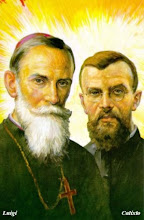Today we remember in the Church St. Augustine of Canterbury. St. Augustine was the great Apostle of England and you can learn more from the following post I found at the Monastery of Christ in the Desert:
The man who would become the first Archbishop of Canterbury and eventually be acclaimed as the "Apostle of England" was the prior of the Abbey of St. Andrew in Rome when, in AD 596 Pope St. Gregory I selected him to head a missionary effort aimed at converting the Anglo-Saxons.
Although difficulties encountered in southern Gaul forced him to return to Rome, the pope promptly consecrated him a bishop and dispatched him again. This time the the endeavor met with success and the party reached Ebbsfleet on the Kentish coast in 597, to be warmly welcomed by King Ethelbert of Kent and his Christian wife. The monarch gave the monks permission to evangelize, and soon provided them with an old church in his city of Canterbury, as well as a place in which to live. Before long Ethelbert and many of his courtiers and subjects would be baptized.
Augustine then journeyed to Arles to be invested with the pallium as bishop of the English by St. Virgilius. Thus empowered, he set about establishing bishoprics in London and Rochester. Pope Gregory had desired that the principal See be situated in London with a second in York, both of which would have twelve suffragens. But Augustine thought otherwise, electing instead to remain in Canterbury, a city which he felt to be not only the most culturally sophisticated but also the most important for the Church, since it happened to be the capital of the only Christian Anglo-Saxon kingdom. It was there he built the Cathedral of Christ Church. Outside the walls, King Ethelbert erected the Abbey of SS. Peter and Paul, later to be renamed after the kingdom's first archbishop.
Gregory instructed Augustine carefully on matters pertaining to the integration of this new territory into the Roman Church. Extant letters show that as long as his actions remained canonically correct he was given a certain latitude on decisions concerning the adoption of Gallican liturgical practices. Gregory forbade the outright destruction of pagan temples, and his bishop was strongly encouraged to absorb popular religious rites into Christian feasts whenever possible.
Augustine then journeyed to Arles to be invested with the pallium as bishop of the English by St. Virgilius. Thus empowered, he set about establishing bishoprics in London and Rochester. Pope Gregory had desired that the principal See be situated in London with a second in York, both of which would have twelve suffragens. But Augustine thought otherwise, electing instead to remain in Canterbury, a city which he felt to be not only the most culturally sophisticated but also the most important for the Church, since it happened to be the capital of the only Christian Anglo-Saxon kingdom. It was there he built the Cathedral of Christ Church. Outside the walls, King Ethelbert erected the Abbey of SS. Peter and Paul, later to be renamed after the kingdom's first archbishop.
Gregory instructed Augustine carefully on matters pertaining to the integration of this new territory into the Roman Church. Extant letters show that as long as his actions remained canonically correct he was given a certain latitude on decisions concerning the adoption of Gallican liturgical practices. Gregory forbade the outright destruction of pagan temples, and his bishop was strongly encouraged to absorb popular religious rites into Christian feasts whenever possible.
In 603, Augustine tried to united the Celtic Church with Rome, but without much success. In fact, there had been little in the way of cooperation along these lines during the whole of his time in England. Old attachments to provincial customs and practices were simply too engrained. However, with Canterbury firmly established as the ecclesiastical center of England, use of the Roman Rite and calendar would, after his death be universally accepted.
Shortly before his death in 604 he consecrated Lawrence of Canterbury as his successor. Augustine was buried in the Abbey Church of SS. Peter and Paul.


















No comments:
Post a Comment